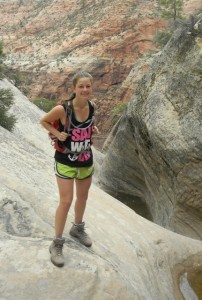
Ana Drehwing '13 at Zion National Park
This summer, Drew Williams ’14 (Collegeville, Pa.) had a birthday he’ll never forget. He and a group of 19 other students got up at 4:30 a.m. to watch the sunrise at Bryce Canyon National Park in Utah and then hiked in 98-degree weather through slot canyons. They ended the day with a snowball fight on top of a laccolith (mass of igneous rock formed from magma that did not reach the surface).
They were part of the summer interim course Geology from A (Arches) to Z (Zion): The Geology of National Parks in the Western United States taught by Larry Malinconico, associate professor of geology and environmental geosciences, and Dave Sunderlin, assistant professor of geology and environmental geosciences. The group visited the national parks within the geologic region known as the Colorado Plateau stretching across northern Arizona and southern Utah. Stops along the way included Bryce, Grand Canyon National Park, Zion National Park, Capitol Reef National Park, Arches National Park, Canyonlands National Park, Sunset Crater Volcano National Monument, Meteor Crater, and Petrified Forest National Park.
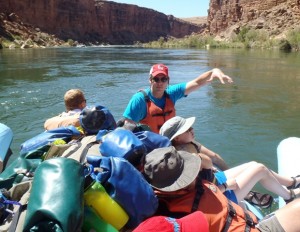
Professor David Sunderlin leads a discussion while floating down the Colorado River.
“In order to fully understand the data that tells us of Earth’s history, I believe you have to be out in the field, noses to the rocks and feet in the stream,” says Sunderlin. “Images on a projector screen or drawings on a chalkboard can only go so far in developing a full appreciation of the complexity of geology and natural history.”
When Ana Drehwing ’13 (Wyckoff, N.J.), a psychology major who had never taken a geology course, saw the textbook concepts firsthand, the overwhelming geology crash course she got over two days on campus before the trip began suddenly made perfect sense. Each time the class went to a new location, it became her new favorite place.
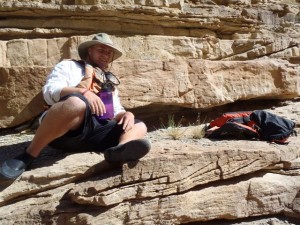
Wesley von Dassow ’13 on the banks of the Colorado River.
“As a person who couldn’t tell the difference between two different rocks, the power of the experience has given me the expertise to look at the world around me in a completely different way,” she says. “What I learned in three weeks would not have been possible without seeing the geology the way we were fortunate enough to witness it. This is the second interim class I’ve taken, and traveling while learning has allowed me to see what I have seen through the specific lens of the class material – something that is beneficial, exciting, and extremely worthwhile.”
Geology major Alexandria Brannick ’12 (Pleasant, N.J.) says that talking about how climate affects geology is one thing, but experiencing it up close is eye-opening. Used to studying the Pennsylvania climate and geology, she found the arid environment of Arizona and Utah fascinating.
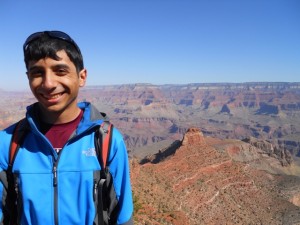
Tyler Fruneaux '14 at the Grand Canyon
“When you’re used to only seeing and being able to touch the geology of our region, it can sometimes become difficult to grasp the concepts of how different climates can affect geology,” she explains. “On this trip we had a chance to actually see, right in front of us, what is going on. The opportunities we had were so amazing, and the educational significance was huge.”
A highlight of the trip for many students, including geology major Jaci White ’13 (Clarksboro, N.J.), neuroscience major Wesley von Dassow ’13 (Sarasota, Fla.), anthropology and sociology major Jeffrey Biel ’12 (Blue Bell, Pa.), and Williams was the three-day, 186-mile whitewater rafting trip down the Colorado River and hike out of the Grand Canyon.
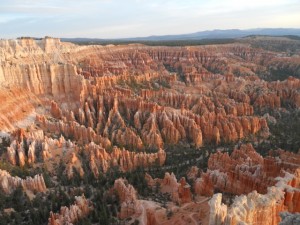
Sunrise at Bryce Canyon
“To start the morning at about zero elevation along the river and end the afternoon at about 2,000 meters elevation along the south rim makes for a strange day,” says White. “Equally fun was camping on the banks of the Colorado River during the night. Without the light pollution of surrounding houses, the stars are really pronounced in the desert. The Grand Canyon was unforgettable.”
“The trip was a great time,” adds Biel. “It changed my perspective of what a class can be. Classes don’t have to be just lectures and PowerPoint slides – they can be firsthand experiences.”
Tyler Fruneaux ’14 had visited Zion before, and on his second visit, it was still his favorite. The diversity of the hikes, which ranged from five miles climbing 1,500 vertical feet to paved trails less than a half mile long, was exciting. There was even what Fruneaux describes as a “go-as-far-as-you-can” hike through the Virgin River called “The Narrows.”
“This has been the best class I’ve taken at Lafayette so far,” he says. “I didn’t really understand what was going on in the classroom, but once we got into the field, I began to recognize certain features, and throughout the course, I really mastered what we had learned. Seeing what we were learning really helped improve my understanding.”
That’s exactly the point of a course like this, especially for such a hands-on discipline like geology, says Malinconico.
“In addition to simply being out of the classroom environment, this course travels through some of the most spectacular landscapes in the world,” he says. “Students each take away something different, but I certainly think they have a better understanding about how different our country actually is. Pictures cannot do justice to the spectacular geology of the desert southwest.”
Von Dassow describes himself as a visual learner, so a course like this was right up his alley. Like many students, he also gained greater perspective pondering how the planet has changed while standing atop 1.7 billion years of Earth history.
“This changed my perspective on how the human race changes the landscape that we inhabit,” he says. “It also helps all of us appreciate the vastness of the time it took for the Earth to form and to get where we are now.”





1 Comment
Comments are closed.